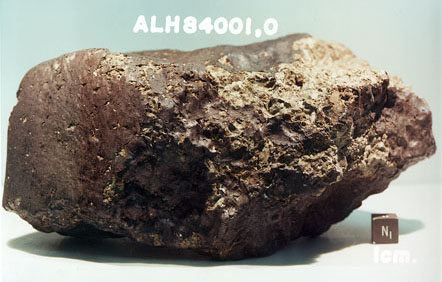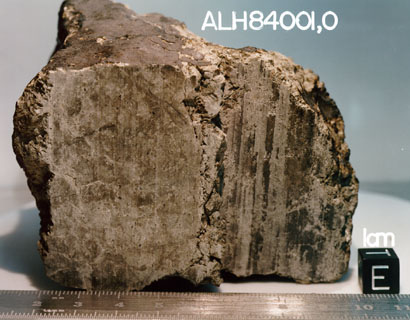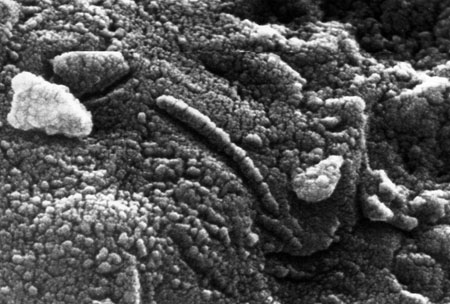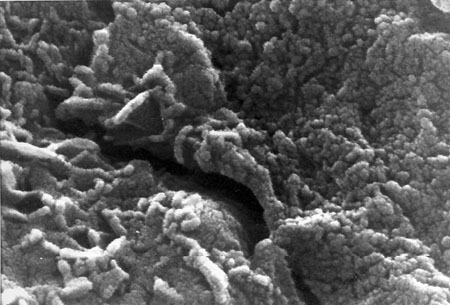
標題: 隕石含細菌化石 力證火星有生命 (圖文) [打印本頁]
作者:
fossilshk 時間: 2009-11-28 07:01 AM 標題: 隕石含細菌化石 力證火星有生命 (圖文)
美國太空總署的科學家提出歷來最具說服力的證據,證明火星上可能有生命,最低限度曾經有微生物存在。大約一萬三千年前,一枚火星隕石撞擊地球,科學家進行深入研究和分析後,在隕石碎片的底層發現只有用顯微鏡才可看到的蟲狀結構。他們認為,幾乎肯定那些是細菌化石。
科學家指出,由於那些蟲狀結構是在隕石碎片的底層被發現,因此推斷它們在隕石撞落地球之前,已經在火星存在,而非屬於地球上的生物。
太空總署約翰遜太空中心的高級科學家麥凱說:「這是一種非常強力的證據,證明火星上有生命。」那枚命名為「艾倫‧希爾斯84001」的隕石,於一九八四年被發現,科學家花了長時間進行研究和分析。在一九九六年發表的另一份報告中,已經有科學家作出類似的結論,但也有其他科學家提出異議及抱懷疑態度。至於上述最新的分析結論,是太空總署科學家利用最先進的高解像電子顯微鏡進行研究後而作出的。
科學家在隕石的內層找到微小的磁性水癥結構,相信那是某些形態的細菌。雖然有些科學家認為那是隕石撞擊地球後產生熱力,導致碳酸分解所造成的現象;但最新的分析結果卻指出,即使是這樣,也不可能在隕石內層形成這種結構。再深入一點研究,顯示那些水癥結構當中,有百分之二十五的成分屬於細菌,與地球上所謂的磁細菌非常相似。
內華達大學天文生物學家拜茲尼斯基說,這份新報告的確提出一些嶄新的理據和解釋,但也不能絕對證明火星上一定有生物存在。畢竟這是一個十分複雜的問題,不能單靠研究一顆隕石,便作出結論。科學家推斷,那顆隕石在宇宙中飄浮了一千六百萬年後,才撞落地球,在南極洲艾倫‧希爾山着陸,分裂成無數細小碎片。科學家發現它的化學成分,與火星大氣中的化學成分相若,因此相信它是來自火星。
2009-11-28 (綜合報道)(星島日報報道)
作者:
fossilshk 時間: 2009-11-28 07:06 AM 標題: 隕石含細菌化石 力證火星有生命 (圖文)

This photograph was taken during the initial processing of ALH84001. Dull, dark fusion crust covers about 80% of the sample.

This photograph shows the sawed face of ALH84001 which has been rotated 90° to the left from the orientation in the slabbing photo. There are actually two cut faces in this photograph. One is on the left side of the rock and represents the original successful cut which separated ,65 from ,0. The face to the right is actually further back in the sample and represents the distance traversed during the attempt to remove the slab. The vertical stripes on the sawed faces were created by friction from the bandsaw blade as it pushed through the rock. These stripes are much more prominent on the second face on the right, indicating the greater difficulty encountered in trying to make the cut. In an effort to minimize contamination, sawing of samples in the Antarctic Meteorite Laboratory at JSC is done in a nitrogen cabinet without any type of lubrication.

This high-resolution scanning electron microscope image shows an unusual tube-like structural form that is less than 1/100th the width of a human hair in size found in meteorite ALH84001. This structure was not part of the published research paper, but it is located in a similar carbonate glob in the sample.

This image taken with an electron microscope shows extremely tiny tubular structures that are possible microscopic fossils of bacteria-like organisms that may have lived on Mars more than 3.6 billion years ago. The largest possible fossils found are less than 1/100th the diameter of a human hair in size, wile most are ten times smaller. These fossil-like structures were found in carbonate minerals formed along pre-existing fractures in the meteorite. They were fashioned similar to the way that fossils occur in limestone on Earth, although on a microscopic scale.
作者:
unknown12 時間: 2009-11-28 06:58 PM
Wow !!!!!!
作者:
寒武紀 時間: 2009-11-28 09:34 PM
外星有生命是肯定的
作者:
stonecold 時間: 2009-11-30 11:25 AM
為什麼細菌在隕石中高溫也不死亡的
作者:
tuff 時間: 2009-12-1 06:40 PM
解開了科學界歷來的一個大問題
作者:
c7 時間: 2009-12-2 10:59 AM
QUOTE:
原帖由 stonecold 於 2009-11-30 11:25 AM 發表
為什麼細菌在隕石中高溫也不死亡的
可能是形成化石後才隕落的
作者:
fossilshk 時間: 2009-12-12 01:50 AM
QUOTE:
原帖由 stonecold 於 2009-11-30 11:25 AM 發表
為什麼細菌在隕石中高溫也不死亡的
有些細菌是能抵禦高溫的
作者:
寒武紀 時間: 2009-12-26 04:32 PM
QUOTE:
原帖由 fossilshk 於 2009-12-12 01:50 AM 發表
有些細菌是能抵禦高溫的
同意
| 歡迎光臨 化石講場-Fossils Board (http://www.fossilshk.com/forum/) |
Powered by Discuz! 4.1.0 |




